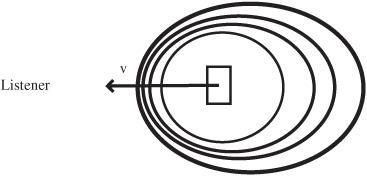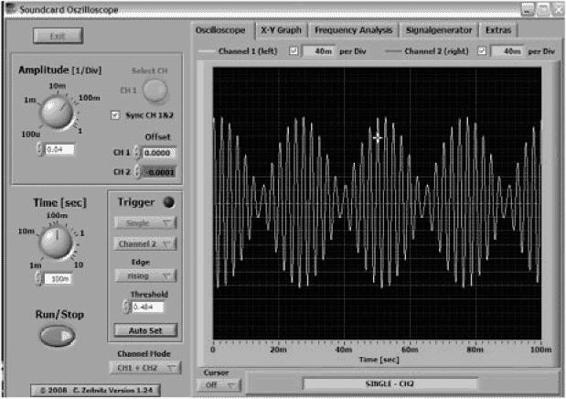Read 125 Physics Projects for the Evil Genius Online
Authors: Jerry Silver
125 Physics Projects for the Evil Genius (43 page)

One way to think about this is that, at the speed of sound, the sound goes to the bottom of the column and back in the same time as the tuning fork goes through one vibration.
Another way to say this is the frequency of the standing wave that resonates equals the frequency of the tuning fork. The wave equation states that the velocity of a wave equals its wavelength times its frequency. The equation is
v = λf
where
v
is the velocity (in m/s), λ is the wavelength (in m), and
f
is the frequency (in cycles per second or Hz).
Compare this method to the other methods of measuring the speed of sound found in this book.
The speed of sound can be determined by measuring the length of an air column at which a tuning fork establishes a resonance. One-quarter wavelength fits in the air column. Measuring the air column can then determine the wavelength of the sound. This combined with the frequency determines the speed of sound.
Racing against sound. Doppler effect
.
Weather forecasters use the Doppler effect to detect wind shear. Astronomers use it to determine that distant galaxies are moving away from each other in an apparent expansion of the universe. This experiment demonstrates how the frequency of a sound moving toward or away from a listener is affected by the Doppler effect.
- 1 meter length of string
- 1 electric buzzer or other source of a sustained note (the buzzer must have a point of attachment for a piece of string and must not require someone to continuously activate a switch to make it sound)
- 2 people
- optional: microphone, oscilloscope, or sound card oscilloscope
- Securely attach the buzzer to the string.
- Turn on the buzzer.
- One person spins the buzzer in a circle, moving toward and away from the second person, as shown in
Figure 74-1
. - The observer should listen to the sound the buzzer makes as it comes toward and away from where they are located.
The
pitch
of the sound increases and decreases at a rate established by the period of the rotating buzzer. The volume of the buzzer sound may also increase and decrease, but that is
not
the Doppler effect. The faster the buzzer spins, the greater the difference in pitch.
The pitch is higher as the sound moves toward you and lower as it moves away from you.
When sound is coming toward you, the peaks and troughs of the waves are closer together, as indicated in
Figure 74-2
. This results in a higher frequency of the sound wave. From the perspective of the listener, the sound waves seem to come more frequently and are perceived to have a higher pitch.
Attach the microphone to either a physical oscilloscope or a sound card oscilloscope. Display the sound and compare the frequency produced by the buzzer coming and going.

Figure 74-1
Sound varies in pitch as it moves with respect to the listener
.

Figure 74-2
As the buzzer moves toward the listener, the perceived pitch of the sound is higher. As it goes around the circle and moves away from the listener, the pitch becomes lower
.
Attach a buzzer to any object that can move in a more or less horizontal direction (such as an air track glider, a frictionless cart, or even an old skateboard). As the object moves, listen to the sound. If you can, also try displaying the waveform on an oscilloscope.
The Doppler effect occurs when the source of the sound is either moving toward you or away from you. When the source of sound is moving toward you, the pitch or frequency of the sound is higher; when the source of sound is moving away from you, the pitch is lower.
Adding sounds. Beat frequency
.
When waves meet up at the same point in space, the waves add together to form a new wave. This combining of waves is called
superposition
. The waves add together in a process called
interference
. If the crests form at the same place, we have constructive interference and the combined wave is smaller. If a crest meets a trough, we have destructive interference and a smaller wave.
Sometimes when waves combine, the pattern they produce is itself a wave. We can hear the beat frequency of a sound wave most easily when two sound waves are separated by a small frequency difference.
- source of two tones that differ by a few Hz. Some options for this include:
– adjustable tuning fork pair with resonant cavities
– 2 matched tuning forks, one of which can be detuned by applying a small mass to the tines of one of the tuning forks
– (Polyphonic) keyboard synthesizer
- waveform generator with two channels or two waveform generators
- optional: a good pair of ears
- optional: an oscilloscope—either a physical instrument or a sound card oscilloscope
- Play two tones at the same time that are different by only a few Hz. For instance, you can use 440 and 445 Hz. Or, you can play two notes on a keyboard separated by a step or two.
- Listen carefully. See if you can distinguish the first tone and the second tone individually. Then, listen for a fading in and out of the overall sound. That throbbing of the basic tone is called the
beat frequency
. The pulsation itself has a frequency equal to the difference between each of the two individual frequencies. - Using the technique developed in
Project 64
, display the combined waves for each of the tones on the oscilloscope. - Measure the frequency of the overall pulsating wave pattern that envelops both waves. Compare that to the difference in frequency for each of the two individual waves.
You should hear a pulsating throbbing tone that causes the combined tones to periodically grow louder and softer.
As an example, by combining a 440 Hz wave with a 445 Hz wave, you get a combined tone that gets louder and softer every five seconds, as shown in
Figure 75-1
. The beat frequency is the difference between the two original waves.

Figure 75-1
Addition of two frequencies produces a beat frequency
.
When two waves are produced at the same location, the beat frequency equals the difference between the frequencies of the two waves.
We can also look at the product of the two waves that exaggerates the overall pattern of the beat frequency, as shown in
Figure 75-2
. Many oscilloscopes display the product of the two input waveforms.

Figure 75-2
Multiplying the amplitudes of two sound waves shows the beat frequency more prominently
.
The beat frequency is the difference between the frequencies of the two individual waves.
Pendulum waves
.
This demonstration uses an apparatus built from several different masses hanging from strings. Each pendulum is slightly shorter than its neighbor. Because the period of a pendulum is longer for longer string, each pendulum will go back and forth in slightly less time than its neighbor. This difference results in an overall changing pattern of standing waves and traveling waves.
- 8–12 small uniform masses (nuts, hooked masses)
- string or fishing line
- frame, as shown in
Figures 76-1
and
76-2
, which allows the string for each successive mass pendulum to become progressively larger - This apparatus is also commercially available from Edmunds Scientific (item number 3123752).
The following equation (from
Pendulum Waves: The Physics of a Set of Tuned Pendulums
, Brad De Gregorio, found at member.cox.net/brad.degregorio/PendulumWave.pdf) gives the optimal lengths for each pendulum string:
Length of nth pendulum string:

where, T
max
is the period of the longest pendulum,
k
is the number of cycles the apparatus goes through before repeating its pattern, and
n
is the number of the pendulum (n = 1 is the first pendulum, n = 2 is the second, and so on).
